

Scientists_record_the_final_activity_of_brain_cells_before_death. An Ancient Virus May Be Responsible for Human Consciousness. You've got an ancient virus in your brain.

In fact, you've got an ancient virus at the very root of your conscious thought. Though it may sound surprising that bits of human genetic code come from viruses, it's actually more common than you might think: A review published in Cell in 2016 found that between 40 and 80 percent of the human genome arrived from some archaic viral invasion. [Unraveling the Human Genome: 6 Molecular Milestones] That's because viruses aren't just critters that try to make a home in a body, the way bacteria do. Instead, as Live Science has previously reported, a virus is a genetic parasite. But the new papers take things a step further. Shortly after a synapse fires, the viral gene known as Arc comes to life, writing its instructions down as bits of mobile genetic code known as RNA, the researchers found. RNA is DNA's messenger and agent in the world outside the cell's nucleus.
Evidence For Higher State of Consciousness Found. The first study to show higher brain-signal diversity than normal when people are awake.
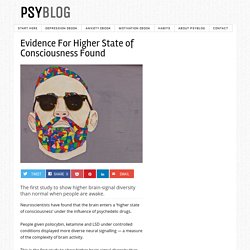
Neuroscientists have found that the brain enters a ‘higher state of consciousness’ under the influence of psychedelic drugs. People given psilocybin, ketamine and LSD under controlled conditions displayed more diverse neural signalling — a measure of the complexity of brain activity. This is the first study to show higher brain-signal diversity than normal when people are awake. Professor Anil Seth, one of the study’s authors, said: Consciousness Began When the Gods Stopped Speaking: Julian Jaynes’ Famous 1970s Theory. Julian Jaynes was living out of a couple of suitcases in a Princeton dorm in the early 1970s.

He must have been an odd sight there among the undergraduates, some of whom knew him as a lecturer who taught psychology, holding forth in a deep baritone voice. He was in his early 50s, a fairly heavy drinker, untenured, and apparently uninterested in tenure. His position was marginal. “I don’t think the university was paying him on a regular basis,” recalls Roy Baumeister, then a student at Princeton and today a professor of psychology at Florida State University. Dying may not be as frightening as we imagine it will be. Sign Up for Our free email newsletters A few years ago, psychological scientist Kurt Gray came across the final statements of 500 Texas inmates executed between 1982 and 2013.
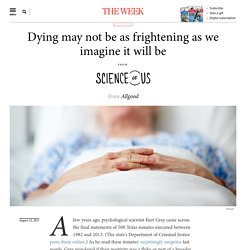
(The state's Department of Criminal Justice posts them online.) As he read these inmates' surprisingly sanguine last words, Gray wondered if their positivity was a fluke or part of a broader psychological trend. So he conducted a study at the University of North Carolina, Chapel Hill, which compared the words of death row inmates and terminally ill patients to those simply imagining they were close to death. In the first phase of the study, Gray and his colleagues analyzed the blog posts of terminally ill patients with cancer or amyotrophic lateral sclerosis (ALS), which the patients had kept on their own, independent of the study. The results showed that the terminally ill patients' words were more positive on average than the ones written by the non-patients.
A Radical Not-So-New Theory: "The Universe Exists Because We Are Here" (VIEW VIDEO) - The Daily Galaxy. The question that intrigued the great American physicist John Archibald Wheeler in the last decades of his life was: “Are life and mind irrelevant to the structure of the universe, or are they central to it?”
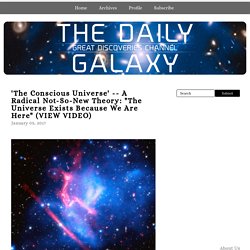
He suggested that the nature of reality was revealed by the bizarre laws of quantum mechanics. According to the quantum theory, before the observation is made, a subatomic particle exists in several states, called a superposition (or, as Wheeler called it, a ‘smoky dragon’). How and why exactly did consciousness become a probl... Growing up in Australia, I loved to lie on the grass, immersed in the scent of wattles, and stare up at the sky.
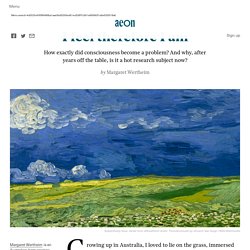
A sky like no other; a deeper, richer shade of blue than anywhere else I have been – and I’ve travelled on all seven continents, including Antarctica. Australians speculate that the colour of our sky results from its unusually thin ozone layer, a physical anomaly leading to sensory saturation. Physicists Say Consciousness May Be A State Of Matter: The Non-Physical Is Indeed Real. The Afterlife May Be Nothing Like We've Ever Imagined. Sleepwalkers feel no pain, remain asleep despite suffering injuries: Study is first to focus on pain experienced during sleepwalking. A new study of sleepwalkers found an intriguing paradox: Although sleepwalkers have an increased risk for headaches and migraines while awake, during sleepwalking episodes they are unlikely to feel pain even while suffering an injury.
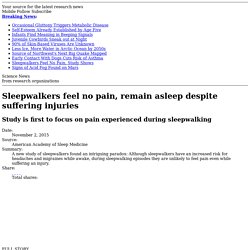
Results show that sleepwalkers were nearly 4 times more likely than controls to report a history of headaches (odds ratio = 3.80) and 10 times more likely to report experiencing migraines (OR = 10.04), after adjusting for potential confounders such as insomnia and depression. Among sleepwalkers with at least one previous sleepwalking episode that involved an injury, 79 percent perceived no pain during the episode, allowing them to remain asleep despite hurting themselves. How much consciousness does an octopus have? Or an iPhone?
What about an iPhone?
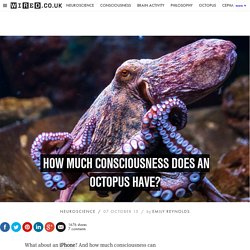
Weird things start to happen when you stare into someone's eyes for 10 minutes. Giovanni Caputo recruited 20 young adults (15 women) to form pairs.

Each pair sat in chairs opposite each other, one metre apart, in a large, dimly lit room. Weird things start to happen when you stare into someone's eyes for 10 minutes. Discovery of Quantum Vibrations Inside Brain Neurons Supports Controversial Theory of Consciousness. Is your brain connected to the universe at a quantum level?
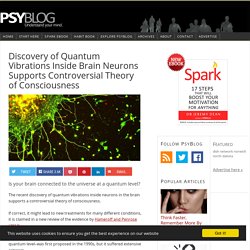
The recent discovery of quantum vibrations inside neurons in the brain supports a controversial theory of consciousness. If correct, it might lead to new treatments for many different conditions, it is claimed in a new review of the evidence by Hameroff and Penrose (2013). The theory–which implies the brain is connected to the universe at a quantum level–was first proposed in the 1990s, but it suffered extensive criticism. One major point against it was that the brain was thought to be too “warm, wet and noisy” for coherent quantum processes.
Recent evidence, though, from researchers led by Anirban Bandyopadhyay has found the proposed quantum vibrations inside microtubules within brain neurons. Consciousness has less control than believed, according to new theory. Consciousness -- the internal dialogue that seems to govern one's thoughts and actions -- is far less powerful than people believe, serving as a passive conduit rather than an active force that exerts control, according to a new theory proposed by an SF State researcher. Associate Professor of Psychology Ezequiel Morsella's "Passive Frame Theory" suggests that the conscious mind is like an interpreter helping speakers of different languages communicate. Your Brain Can’t Handle the Moon - Issue 24: Error. What is this new theory?” The long-retired New York University cognitive psychologist, Lloyd Kaufman, asked me.
We were sitting behind the wooden desk of his cozy home office. He had a stack of all his papers on the moon illusion, freshly printed, waiting for me on the adjacent futon. But I couldn’t think of a better way to start our discussion than to have him respond to the latest thesis claiming to explain what has gone, for thousands of years, unexplained: Why does the moon look bigger when it’s near the horizon? He scooted closer to his iMac, tilted his head and began to read the MIT Technology Review article I had pulled up.1 I thought I’d have a few moments to appreciate, as he read, the view of New York City outside the 28th floor window of his Floral Park apartment, but within a half-minute he told me, “Well, it’s clearly wrong.”
It wasn’t even my theory, yet I felt astonished. Consciousness Began When the Gods Stopped Speaking: Julian Jaynes’ Famous 1970s Theory. Julian Jaynes was living out of a couple of suitcases in a Princeton dorm in the early 1970s. He must have been an odd sight there among the undergraduates, some of whom knew him as a lecturer who taught psychology, holding forth in a deep baritone voice. He was in his early 50s, a fairly heavy drinker, untenured, and apparently uninterested in tenure. His position was marginal. “I don’t think the university was paying him on a regular basis,” recalls Roy Baumeister, then a student at Princeton and today a professor of psychology at Florida State University. Quantum Approaches to Consciousness. 1. Introduction The problem of how mind and matter are related to each other has many facets, and it can be approached from many different starting points. Of course, the historically leading disciplines in this respect are philosophy and psychology, which were later joined by behavioral science, cognitive science and neuroscience.
In addition, the physics of complex systems and quantum physics have played stimulating roles in the discussion from their beginnings. Previously undetected link between brain and immune system discovered. Study: Majority Of Frontal Lobe Occupied By Thoughts Of Sausage Links - The Onion - America's Finest News Source. Is this life real or a simulation? – Matthew R Francis. Dr. Michael J. Breus. The Octave of Energy. The Nature of Mind and the Holographic Brain - War Is Crime. The purpose of this article is to provide evidence that strongly indicates that you are not your brain, or your body for that matter, and that the nature of mind, of memory, and of our brains may actually be vastly different than we have been lead to believe. Memories Transplanted With Organs. I recently came across an interesting and novel phenomenon via a remarkable fact I read on Kickassfacts.com.
It seems organ recipients sometimes have living memories or peculiar affinities which somehow carried over along from their donor. The Great Consciousness Swindle: Why Philosophers Will Never Find Consciousness, And Why They Secretly Don’t Want To. Scientists Achieve Direct Brain-To-Brain Communication Between Humans. Telepathy is the stuff of science fiction. What do rumors, diseases, and memes have in common? Your Brain, the Internet and the Universe Have Something Fascinating in Common. What Is Consciousness and Do Humans Have a Monopoly on It? ‘Hidden brain signatures’ of consciousness in vegetative state patients discovered. Magic mushrooms expand your mind and amplify your brain’s dreaming areas – here’s how. Everything is Sound and Light, Plus Sigil Generation Technology. Carl Jung: In Defense and Critique. Breakthrough allows scientists to watch how molecules morph into memories.
Video games change the way you dream. Can DMT Connect the Human Brain to a Parallel Universe? Discovery of Quantum Vibrations in 'Microtubules' Inside Brain Neurons Supports Controversial Theory of Consciousness. Why we should rethink what we've been told about consciousness.